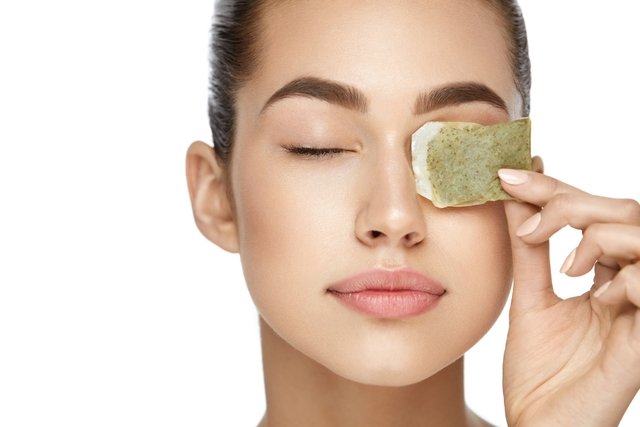Some home remedies for eye irritation, such as applying warm or cold compresses, using chamomile tea or calendula solution, help reduce inflammation, swelling or discomfort in the eyes caused by dry eye, conjunctivitis or blepharitis, for example. example, as they have anti-inflammatory, antiseptic and calming properties.
Furthermore, these home remedies help reduce the secretions that the eyes produce when they are irritated, thus relieving some unpleasant symptoms such as itching, burning and redness.
Home remedies can help relieve eye irritation, however, they do not replace treatment recommended by your doctor. Therefore, it is recommended to consult an ophthalmologist whenever irritation, redness, itching or burning in the eyes appears, so that the most appropriate treatment can be diagnosed and initiated according to its cause. See the main causes of eye irritation.

Top home remedies for eye irritation
Some home remedy options for eye irritation are:
1. Chamomile tea
Chamomile tea can be used in the form of compresses applied to the eyelid, as it has anti-inflammatory and calming properties, which help to relieve irritation and inflammation in the eye, caused by conjunctivitis, for example.
Ingredients
- 20 to 30 g of fresh or dried chamomile flowers;
- 500 mL of boiling water.
Preparation mode
Add fresh or dried chamomile flowers to boiling water and leave to rest for 15 minutes. Strain and let cool naturally or place the chamomile infusion in the refrigerator for 10 to 20 minutes. Wet a gauze pad and apply it to the closed eye for 15 to 30 minutes, at least twice a day.
Another option is to use a chamomile tea bag to prepare the infusion and apply the bag to the affected eye, after it has cooled in the refrigerator.
2. Calendula Solution
The calendula solution, prepared with the medicinal plant Calendula officinalishas anti-inflammatory properties that help relieve eye irritation, itching and discomfort caused by allergic conjunctivitis or follicular conjunctivitis.
Ingredients
- 2 tablespoons of dry calendula;
- 250 mL of boiling water.
Preparation mode
Add the calendula to the boiling water, cover and let it rest for about 15 minutes. Then, strain it, wait for it to cool, and dip a clean gauze pad into the calendula solution. Squeeze the gauze slightly to remove excess calendula solution and apply it to the closed eye, that is, on the eyelid, for 15 minutes. After this time, remove the gauze and discard it. You can use the calendula solution up to 6 times a day.
If both eyes are affected by conjunctivitis, a gauze pad with the calendula solution should be used for each eye separately and discarded after use.
3. Green tea
Green tea, made from the plant Camellia sinensiscan be used as a compress on the eyes, as it has phenolic compounds in its composition, especially epigallocatechin, which has anti-inflammatory properties that help reduce inflammation and irritation in the eye, in addition to reducing swelling in the eyelids.
Ingredients
- 1 bag of green tea;
- 1 cup of boiling water.
Preparation mode
Add the green tea bag to the cup of boiling water and let it steep for 10 minutes. Then, remove the tea bag and place it in the refrigerator for 20 to 30 minutes to cool. Once cooled, apply the green tea bag to the closed eye for 5 minutes, up to twice a day.
4. Euphrasia compress
The euphrasia compress, made with medicinal plants Euphrasia officinaliscan be used for conjunctivitis or blepharitis, as it helps to relieve eye irritation due to its calming properties.
Ingredients
- 1 teaspoon of dry euphrasia;
- 250 mL of water.
Preparation mode
Bring the water to a boil and, after boiling, pour the euphrasia into a container and cover, letting it rest for 15 minutes. Use a filter to strain and soak cotton balls or sterile gauze in the solution, then apply to irritated eyes at least 3 times a day for 10 minutes.
5. Hydraste tea
Hydraste tea, made from the medicinal plant Hydrastis canadensishas anti-inflammatory and antiseptic properties, which help to calm eye irritation and combat inflammation, and can be used in the form of compresses for conjunctivitis, for example.
Ingredients
- 1 teaspoon of hydraste root powder;
- 250 mL of boiling water.
Preparation mode
Add the powdered hydraste to the boiling water, mix, cover and let it rest for about 15 minutes. Strain the tea through a coffee filter to remove all particles of hydraste powder. Then, wait for the hydraste tea to become warm and wet a clean gauze with the tea.
Squeeze the gauze slightly to remove excess hydraste tea and apply it to the closed eye, that is, on the eyelid, for 5 to 10 minutes. After this time, remove the gauze and discard it. Hydraste tea can be used up to 3 times a day.
6. Saline compress
The compress with 0.9% saline solution helps to relieve discomfort and irritation in the eyes, in addition to cleaning excess secretions that may be present in the corner of the eye or on the eyelids. unique, which can be found in pharmacies or drugstores.
In addition, you can also apply a few drops of saline solution to the eyes to help eliminate any object that may be causing irritation, such as specks or contact with irritating substances.
Ingredients
- Saline 0.9%;
- Sterile Gaze.
Preparation mode
Place the 0.9% saline solution in the refrigerator and wait for it to cool. Then, wet the sterile gauze with the cooled 0.9% saline solution and place it over the closed eyes.
To clean the eyelids and the area around the eyes, the saline compress should be passed from the corner of the eye outwards, to help clean the secretions in the eyes. It is important to use gauze for each eye and after cleaning, the used gauze and serum bottle must be discarded.
0.9% saline solution can also be found in individual single-use packaging, in which 2 to 3 drops can be placed in the eye to wash the eyes and thus relieve irritation in cases of specks or contact with irritating substances. However, it is not recommended to apply drops frequently, as excess salt can cause or worsen eye irritation.
After using saline solution in individual packaging, any unused quantity must be discarded to avoid the risk of contamination of the solution. In the case of larger packages, the serum can be kept in the refrigerator for a maximum of 3 days. After this period, any unused quantity must be discarded.
7. Warm compresses
Warm compresses help reduce eye irritation caused by blepharitis, meibomitis, conjunctivitis or dry eyes, for example, relieving pain and discomfort.
Ingredients
- Gaze barren;
- Warm water.
Preparation mode
Heat the water over a fire, but do not let it boil. Wet the sterile gauze in warm water, squeeze to remove excess water and apply to the affected eye, leaving it to act for about 2 to 3 minutes. After this time, remove the gauze and discard it.
If the irritation is in both eyes, sterile gauze should be used for each eye and then discarded.
It is important that the water is warm, so you should test the temperature by placing a little water on the back of your hand. If it is very hot, let it cool a little, as very hot water can cause burns to the eyelids or the area around the eyes.
8. Cold compresses
Cold compresses are a good option to reduce eye irritation, eyelid swelling, pain and discomfort caused by conjunctivitis.
Ingredients
- Gaze barren;
- 250 mL of cold water.
Preparation mode
Wet the sterile gauze in cold water and apply it to the eyelid of the closed eye, leaving it to act for a few minutes until you feel an improvement in your symptoms. When it stops being cold, change it and put on another cold compress. Discard the gauze after use.
How to avoid eye irritation
To avoid eye irritation, it is important to avoid sleeping with makeup on, wear sunglasses, avoid using eye drops without medical advice and sleep well. Additionally, it is recommended to wear swimming goggles when going to the pool, as chlorine can cause irritation. See what care you should take with your eyes.

Sign up for our newsletter and stay up to date with exclusive news
that can transform your routine!
Warning: Undefined array key "title" in /home/storelat/public_html/wp-content/plugins/link-whisper-premium/templates/frontend/related-posts.php on line 12
Warning: Undefined array key "title_tag" in /home/storelat/public_html/wp-content/plugins/link-whisper-premium/templates/frontend/related-posts.php on line 13



